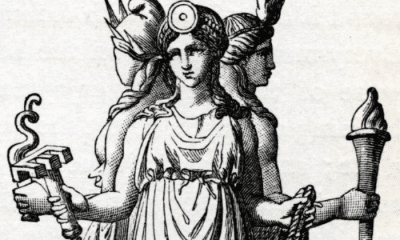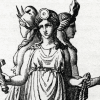Greek
How the Furies Became Kind in Eumenides
The Furies were terrifying goddesses, so why were they sometimes called The Kindly Ones? Read more to learn how the spirits of vengeance became the Eumenides!
The Erinyes were goddesses who doled out a brutal form of justice. Transgressions against the gods, men, or natural law were met with terrible, endless torment.
These goddesses were so unrelenting and fearsome that their name is still used to describe anger and hatred today. In English, they are called the Furies.
Their fury, however, was eventually softened. In a famous Greek play by the same name, they earned the title of Eumenides.
As The Kindly Ones, the Eumenides still hounded those who had committed grave crimes. They also protected the innocent, however, and could show mercy when circumstances warranted it.
The transition from bestial spirits of vengeance to the kinder Eumenides was not limited to a single play. It was part of a broader trend that saw the idea of justice move away from pure punishment.
From Erinyes to Eumenides
The Erinyes, or Furies, were some of the most feared creatures in Greek mythology.
The Furies were the embodiment of punishment, specifically for those who broke oaths, betrayed their families, offended the gods, or commited murder.
Although they could be terrifying, the Erinyes were not monsters. They were goddesses whose actions were the will of Zeus as the keeper of natural law.
According to legend, the Furies were born from the blood of Uranus. When he was castrated by Cronus, his blood fell to the earth and created the Erinyes, nymphs, and giants.
The account was not universally accepted, however. Some believed that they were daughters of Nyx, the primordial goddess of night, or Hades.
Most writers claimed that there were three Furies. Virgil, who was probably working from an older Greek source, named them Alecto (Endless Anger), Megaera (Jealous Rage), and Tisiphone (Vengeful Destruction).
While many writers described the three Erinyes as withered crones, artists often showed them as more beautiful maidens. Older sources also gave them frightening features such as bats’ wings, dogs’ heads, and glowing red eyes.
The Furies often carried whips, which they used to torment their victims. Those who committed grave offenses would be hounded by the Furies, usually with no way of ending their punishment until death.
The Erinyes were often seen as spirits of vengeance and punishment, but over time their role began to change.
The turning point for the Furies can be seen in the Oresteia, a trilogy of tragic plays by the Athenian writer Aeschylus. It is one of two known works from the 5th century BC that show a changing attitude toward the Furies.
According to the legend of Orestes, which was well known before Aeschylus’s time, King Agamemnon was killed by his wife, Clytemnestra, after he returned from the Trojan War. Their son Orestes was commanded by Apollo to avenge his father’s death.
After many years in exile, Orestes returned to Mycenae in disguise as a messenger. Pretending that he brought news of his own death, he gained entry into the palace and killed his mother and her new lover.
Murdering one’s own mother was a grave offense against natural law, regardless of the motive. Orestes was set upon by the Furies, who were relentless in their punishment.
In the final play of the trilogy, Eumenedes, Apollo sent Orestes to Athens to petition Athena for aid. The goddess of wisdom decided that Orestes should be judged by his peers rather than by the gods.
She assembled twelve Athenian citizens to determine Orestes’ fate, creating the first ever trial by jury. Athena presided as judge.
The Erinyes put forward their case, rightly claiming that Orestes belonged to them for the crime of killing his own mother. As more ancient deities, they said, they took precedence over younger gods like Apollo and Athena.
Apollo argued on behalf of the defense. He said that no punishment was warranted since the law gave Orestes the right to avenge his father.
The jury was split, so Athena cast the deciding vote. She ruled in favor of Orestes and declared that he was no longer subject to punishment from the Erinyes.
The Furies were incensed and vowed to torment all of Athens to punish the people for Athena’s ruling.
To make peace, Athena offered them a new role. Instead of being goddesses of retribution, they could become goddesses of justice. Rather than continuing cycles of vengeance for generations, they could mete out justice when needed and show mercy when it was warranted.
Athena offered to make them venerated protectors of her city, as well. As a slight bribe, she also hinted to them that she could give them access to the storehouse where Zeus kept his thunderbolts.
The Erinyes were satisfied and took on a new role in Athens. They became the Eumenides, “The Kindly Ones,” who punished only those who were truly deserving, sought justice for those who were wronged, and protected the city of Athens from harm.
My Modern Translation
Aeschylus was not the first writer to refer to the Furies as The Kindly Ones. Shortly before his plays were written, Euripedes also called them the Eumenides.
Although Euripedes was also recounting the story of Orestes, his reason for styling the Furies as the Eumenides was quite different.
The use of euphemisms to refer to negative forces was a common trait in Greek literature. Hades, for example, was often called Pluton, “Wealthy.”
By using an alternative name for such beings, the Greeks believed that they could avoid attracting their attention. The Erinyes would be more likely to target someone who had invoked them by name than they would if that person avoided speaking about them directly.
These epithets were often more positive, as well. By flattering potentially dangerous deities, people hoped to gain their favor and avoid their anger.
The tradition of calling the Erinyes by a more kind name, such as the Eumenides, was likely well-established before the 5th century BC.
Aeschylus, however, gave a new reason for the epithet’s use.
He expanded the existing story of Orestes and the Furies to give them a new role that was more in keeping with the existing epithet. Although they were still goddesses of punishment, there was no longer a reason for innocent or just people to fear invoking them.
This evolving view of the Eumenides fit not only with how they had changed over time, but also how Greek ideas of the Underworld, death, and divine justice had changed as well.
In earlier writings, such as those of Homer, the Furies were shown as almost monstrous. They were frightening, inhuman spirits who had all the markers of Underworld beings.
This image changed over time, however. The Erinyes became less bestial and, by the time of Aeschylus, were often shown in both art and literature as furious but beautiful maiden goddesses.
This fits with an overall theme of chthonic beings and places becoming less menacing over time.
The realm of Hades, for example, was viewed in early periods as a grim and dismal place. Even for great heroes and leaders, there were no rewards in the afterlife.
Over time, however, a more hopeful view emerged. The development of the Elysian Fields and the idea of reincarnation gave the possibility that the Underworld could be a paradise for those who earned it.
The rehabilitation of the Furies into the Eumenides was part of a larger trend in Greek culture, particularly in Athens. As law emerged and society became more stable, a view of justice began to form that was less focused on punishment.
This idea held that reward could be as much of a part of justice as retribution. Mercy, whether from the Eumenides or in the Underworld, was sometimes warranted.
The development of the Eumenides as goddesses of mercy used the divine to show how human law and society were changing. Rather than focusing only on vengeance and punishment, the Eumenides could represent a form of justice that allowed for mercy and forgiveness.
In Summary
The Furies were ferocious goddesses in Greek mythology. They were spirits of vengeance who relentlessly tormented men who committed crimes against society, the gods, or nature.
Fearing to even invoke their name, some Greeks called the the Eumenides, or “The Kindly Ones.” By giving them a more pleasant epithet, it was hoped that innocent people could avoid attracting their infamous wrath.
This epithet gradually took on a different meaning, however. In Aeschylus’ play Eumenides, the Furies were given a new role as goddesses of justice rather than only punishment.
The trial of Orestes in the play and the new role of the Eumenides reflected broader trends in Greek society, particularly in Athens.
New views of law in the society were reflected in new ideas about chtholic deities and the Underworld, including the Furies. Rather than focusing only on punishment and revenge, divine law was also seen to have a new concept of mercy and reward as part of its justice.
The new idea of the Eumenides as goddesses who could be truly kind reflected human society in mythology. Just as the people of Athens were reworking their idea of what justice entailed, so too were the gods.



